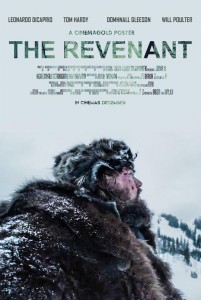The Revenant
Posted on January 7, 2016 at 5:35 pm
B+| Lowest Recommended Age: | Mature High Schooler |
| MPAA Rating: | Rated R for strong frontier combat and violence including gory images, a sexual assault, language and brief nudity |
| Profanity: | Some strong and racist language |
| Alcohol/ Drugs: | Drinking |
| Violence/ Scariness: | Intense, graphic, and disturbing violence including arrows, knives, guns, sexual assault and prolonged animal attack |
| Diversity Issues: | A theme of the movie |
| Date Released to Theaters: | January 8, 2016 |
| Date Released to DVD: | April 18, 2016 |
| Amazon.com ASIN: | B01AB0DX2K |

In the 1820’s, ladies of fashion liked fur trim. And, true then as now, men like money. So frontiersmen went on trapping expeditions into the wilderness of the young country of the United States of America (played here by British Columbia and Alberta, Canada). The rewards for bringing back fur pelts are significant. The risks, including attack by the Arikara Indians, are dire.
A frontiersman named Hugh Glass was the guide for one of these expeditions. According to lore, he was savagely attacked by a bear and left to die by his companions, but survived and made it back over 250 miles to the nearest fort, intent on revenge. The story has been told — and embroidered and adapted — over the years, reflecting each era’s perspective and concerns. This version is based on the novel by US Trade Michael Punke (who, as Deputy US Trade representative and Ambassador to the World Trade Organization is restricted from promoting the film). As co-written and directed by “Birdman’s” Alejandro González Iñárritu it is a story of resolve. As often with Westerns, it is a way to explore the fundamental contradictions of the American spirit: determination, vision, courage, but sometimes without any regard for the damage they can cause.
Both Iñárritu and his Director of Photography Emmanuel Lubezki won Oscars for this film. They filmed only in available light, meaning they had to limit themselves to just moments of filming each day. As the director told Deadline, they created “little-by-little jewel moments; that’s the way I designed the production…But those locations are so gorgeous and so powerful, they look like they have never been touched by a human being, and that’s what I needed.” They filmed under conditions so arduous that Will Poulter, who plays real-life frontiersman/trapper Jim Bridger, told me that no acting was necessary to show that they were freezing and exhausted. The bear is CGI (and the bear attack is truly horrifying), but almost everything else was really there and really happening, including diCaprio’s hacking coughs (he had the flu).
The cinematography is the most stunning I have ever seen, perfectly focussed throughout the depth of field, even across endless vistas. Second only to the visuals is the movie’s real theme, not revenge or even will, but law.
When there is no structure, no church, no police, courts, or jail, no lawmakers, no appeals, how do you decide who is in charge and what to do? The film’s most fascinating moments are the ones where we see characters across the continuum on those questions, with one in particular who is still deciding where he fits in, decide what they should do, what they must do. In an early scene, the Indians attack and the frontiersmen’s response is: pelts payload first, and every man for himself second. Wounded men are left behind without a second’s hesitation.
But when Glass (Oscar-winner Leonardo DiCaprio) is critically wounded in the middle of nowhere, Captain Henry, the leader of the expedition (Domhnall Gleeson) is certain what he is owed. Because he has been an essential and honorable part of their expedition (and, unstated but evident, because no one is shooting arrows at them at the moment), he decides two men will be left behind to care for him until he dies and then give him some semblance of a Christian burial. They are John Fitzgerald (Tom Hardy) and Bridger (17 years old at the time). Glass has a teenage son (Forrest Goodluck), from his marriage to a Native American woman who was killed, and he stays with his father as well.
But Fitzgerald becomes impatient and commits a terrible act of cruelty while Bridger is away from the campsite, then lies to him about what happened. Glass is left for dead. As Glass, Fitzgerald, Henry, and Bridger deal with the consequences of these actions, we see the beginnings of a society and culture. Some day, the pristine landscapes explored by Glass and Bridger would be covered with roads and cities and we will try to re-create them by filming in other countries to show us what we were. But the story of the struggle for justice, always the great work of this country, is a story we will keep telling forever.
Parents should know that this film includes extremely graphic and disturbing human and animal violence with many explicit and disturbing images of dead bodies and wounds, murder of family members, sexual assault, brief nudity, some strong language, and racism.
Family discussion: How many different views about law and morality do you see among the characters? What should the group have done with a severely injured member?
If you like this, try: “Touching the Void,” a documentary about an extraordinary story of survival in the wilderness
